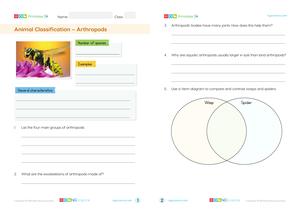Begin with an engaging question: 'What do insects, spiders, and crabs have in common?' Introduce the concept of arthropods as the most diverse group of animals.
Go to the LessonLearning Objectives
- Identify and classify the four main groups of arthropods: insects, arachnids, myriapods, and crustaceans.
- Explain the role of the exoskeleton in arthropods, including its functions and the process of molting.
- Understand the diverse habitats of arthropods and how their physical adaptations, such as jointed appendages, support survival in various environments.
- Describe the role of arthropods in ecosystems, such as nutrient cycling by decomposers like millipedes and pest control by insects like ladybugs.
- Explore the anatomical features and body systems of arthropods, including their bilateral symmetry, paired limbs, and sense organs.
Introduction and Hook
Direct Instruction
Discuss the four main groups of arthropods: insects, arachnids, myriapods, and crustaceans. Highlight key characteristics and examples of each group.
Guided Exploration
Explore the diverse habitats of arthropods and discuss how their physical adaptations, such as jointed appendages, support survival in various environments.
Hands-On Activity
Conduct a classification activity where students sort images or models of various arthropods into their respective groups.
Independent Practice
Assign students to research a specific arthropod and present its unique adaptations and ecological role to the class.
Check for Understanding
Review and Reflection
Facilitate a class discussion on the importance of arthropods in ecosystems, such as their roles in nutrient cycling and pest control.
Encourage students to reflect on what they have learned about arthropods and how these creatures impact their daily lives.
Assessment and Extension
Administer the Unit Quiz to assess comprehension of the arthropods unit.
Try the Quiz





